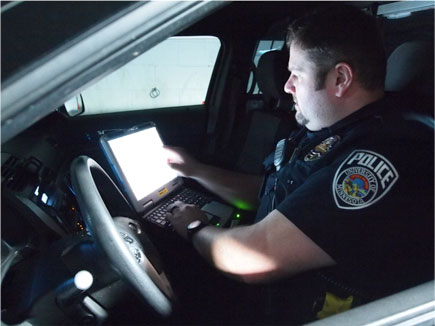Researchers at the U of M’s HumanFIRST Laboratory are helping to make it faster and easier for Minnesota law enforcement officers to log the data they collect at the scene of a crash.
Nichole Morris, principal researcher at the HumanFIRST Lab, and her team redesigned the electronic crash report interface used by Minnesota law enforcement officers to improve the accuracy, reliability, and meaningfulness of crash data. Although at first glance these data appear to serve simply drivers and insurance companies, the information is highly valued because it is used by state and federal agencies, as well as researchers, to analyze and evaluate crashes, trends, and potential countermeasures.
The project was a component of a larger effort that redesigned Minnesota’s crash records database and was sponsored by the Traffic Records Coordinating Committee at the Minnesota Department of Public Safety (DPS) and the Minnesota Department of Transportation. The new interface launched on January 1, 2016, and has since been used to log nearly 30,000 crashes with mostly positive feedback.
HumanFIRST’s work included conducting a human factors analysis and obtaining extensive input from law enforcement officers to design a system that best met their needs. Morris and her team then developed two prototype interfaces that were subsequently built by Appriss, the state’s software vendor.
“One of the biggest things that I hear over and over from officers is how impressed they are and how pleased they are that we started with the officer and built the system up,” says Kathleen Haney, traffic records coordinator at DPS. “Legal and law enforcement software [often treat] the officer as an afterthought, and for us to go out there first and say, ‘How do you want to collect this data?’ has made a huge impact on them.”
The finished system gives officers three choices for electronically submitting a report: a quick capture, a wizard, and a form. Appriss also built a website interface and a standalone platform that can be loaded onto officers’ laptops, allowing them to complete electronic reports even when they have limited Internet access.
“By coupling the work from HumanFIRST with an experienced software vendor, Minnesota was able to get the best-of-breed,” Haney says. “We are unaware of any other state that gives so many options to the officers. And our goal of high-quality data—by easing the burden of collection—was clearly met.”
The project’s success has also garnered national attention. In February, NHTSA administrator Mark Rosekind and regional administrator Darin Jones visited the HumanFIRST Lab to learn about the redesign.
Going forward, the state will continue fine-tuning the interfaces and making enhancements based on officer feedback. Later this year, the state also plans to launch a public portal that will allow citizens to perform aggregated crash data inquiries and run data reports. In other future work, HumanFIRST researchers will evaluate the effectiveness of the new system by examining data accuracy, Morris says.
“The paramount goal of this project was to help officers,” Morris says. “They really put themselves at risk when they’re on the roadside, so the faster we can help them collect and document data and clear the scene, the better. After that, we want to make sure that what we’ve done is resulting in high-quality data.”




